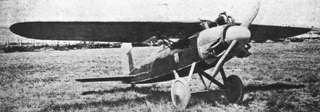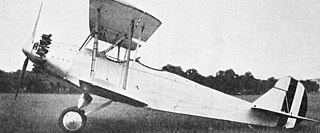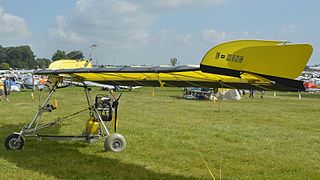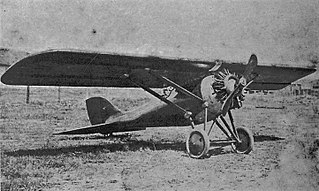
The Aero A.23 was a Czechoslovakian airliner of the 1920s. Aero Vodochody had produced the first Czech airliner, the A.10, four of which had served with ČSA, the national airline. The A.23, another biplane, was bigger, more powerful, and could carry more passengers.

The Albatros L 69 was a two-seat German parasol monoplane racing and training aircraft of 1925. It was a single-engine parasol-wing monoplane of conventional configuration that seated the pilot and passenger in tandem, open cockpits. It was advertised as a trainer, however contemporary reports dismissed this due to the difficulty in accessing the front cockpit, and the designers' focus on performance.

The Albatros L 75 Ass was a German trainer biplane of the 1920s. Of conventional configuration, it seated the pilot and instructor in separate, open cockpits. The wings were single-bay, equal-span, and had a slight stagger. Production continued after Albatros was absorbed by Focke-Wulf.

The Heinkel HD 39 was a special-purpose cargo aircraft developed in Germany in the 1920s to distribute the Berlin newspaper B.Z.. It was a conventional single-bay biplane with staggered wings of equal span, and a fuselage that nearly filled the interplane gap. The pilot sat in an open cockpit, and the undercarriage was of fixed, tailskid type with divided main units. The sole example of the type was built after Ernst Heinkel found out, by chance, that B.Z. required such an aircraft and had ordered two machines from Albatros. Heinkel convinced publisher Ullstein-Verlag to purchase a third aircraft from his firm.

The Keystone K-55 Pronto was a mail plane developed in the United States in the late 1920s.

The IS-5 Kaczka was a single-seat canard research glider designed and built in Poland from 1948.

The Stolp-Adams SA-100 Starduster is an American single-seat sport biplane designed to be built from plans supplied by Aircraft Spruce & Specialty Co. Though the first flight was in 1957, Stardusters continue to be built and flown.

The Cascade Kasperwing I-80 is an American ultralight flying wing motorglider that was designed by Witold Kasper and Steve Grossruck. It was produced by Cascade Ultralites and introduced in 1976. The aircraft was supplied as a kit for amateur construction.

The Albatros L102 / Albatros Al 102, was a German trainer aircraft of the 1930s. It was a parasol-wing landplane, seating the student pilot and instructor in separate, open cockpits. A biplane floatplane version was also built as the Al 102W, with strut-braced lower wings.
The Wier RDW-2 Draggin' Fly was a homebuilt light aircraft, designed in the United States in the 1970s, aimed at fairly inexperienced builders and flyers. Plans were available but only one was built.

The Schoettler I was one of the first aircraft constructed in China, albeit with a German designer. It was a two-seat, single engine biplane, first flown in mid-summer 1923.

The Albatros L.71 was a two-seat, single pusher engined biplane built in Germany in the 1920s.

The Caudron C.140 was a French tandem cockpit sesquiplane designed in 1928 as a combination of liaison aircraft and observer and gunnery trainer.

The Rohrbach Ro VII Robbe was an all-metal, twin engine flying boat built in Germany in the 1920s. It could be adapted to commercial or military rôles.

The Caproni Ca.95 was a large, three engine, long range, heavy bomber prototype built in Italy in 1929. It could carry a 1,600 kg (3,500 lb) bomb load and had three defensive gun positions. Only one was built.

Samolot Sp.I was a type of aircraft designed in Poland in the mid-1920s. It was intended to explore the characteristics of a proposed single seat fighter. The project did not receive government support and only one Sp.I was built.

The all-wood Kozłowski WK.1 Jutrzenka (Dawn) was a two-seat low wing monoplane designed and built in Poland over 1926-7.
The Caproni Ca.66 and Caproni Ca.67 were Italian night bomber aircraft designed to re-equip the post-World War I Regia Aeronautica.

The Thunderbird W-14 was a small, three seat American passenger transport, first flown in 1926, entering production, significantly improved, in 1927 with several different engine options. About 40-50 were built before the financial collapse of the company in 1929.
The sole Kawanishi K-2 was the first specialized Japanese racing aircraft. The advanced, single-seat low-wing monoplane's first flight was in the late summer of 1921. It had a promisingly high maximum speed but a career limited by numerous minor accidents produced no victories or records.


















